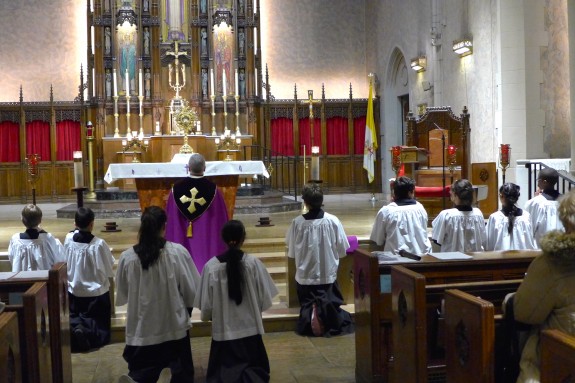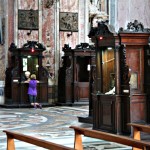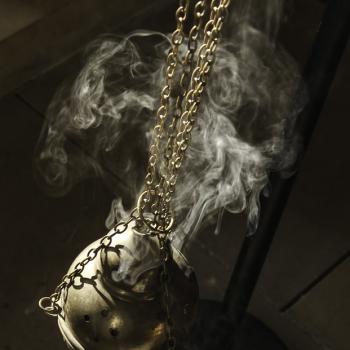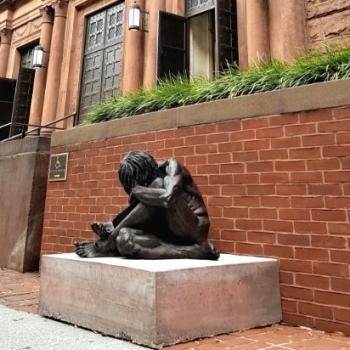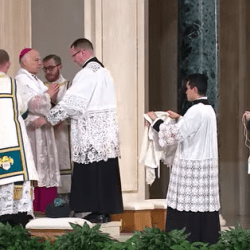Reading about how my parish follows the Stations of the Cross with Benediction, a couple readers have wondered if this is liturgically correct or appropriate.
A deacon candidate noted: “I’m being taught in diaconal formation that Benediction is not a closing to another devotion. Must be linked to the Eucharist.”
Far as I know—and from what I’ve been able to find Googling— there’s nothing explicitly prohibiting Benediction from following a devotion like Stations of the Cross. An Internet search reveals that numerous parishes do this during Lent.
A few years ago, someone posed this question to Zenit’s Father Edward McNamara:
Q: When Benediction is to follow the Way of the Cross, is it proper to have the Blessed Sacrament exposed during the Stations, given the fact that parishioners’ focus is on their prayer book, not the Eucharist, and they have their back to the monstrance for some of the Stations, as the priest moves around the church? —J.T., Surrey, British Columbia
A: There are two questions to be addressed, one regarding the posture of the faithful during a community celebration of the Stations and the second regarding the opportunity of exposing the Blessed Sacrament during the Via Crucis.
Regarding the first question I do not see any particular difficulty in this movement of the faithful even though they may briefly turn their backs to the tabernacle.
Catholics have been practicing the Via Crucis in churches for centuries without this creating any particular problem.
Certainly the presence of Christ in the Eucharist is worthy of all respect and prominence. But our churches, especially our older churches, are not exclusively reserved for the celebration of the sacraments and the adoration of our Lord in the tabernacle.
Certainly no disrespect is shown to the tabernacle if a member of the faithful turns away from it to pray at a side altar, chapel or image dedicated to the Blessed Virgin, a venerated crucifix or a saint to which he or she has a particular devotion.
In such cases, and likewise for the Via Crucis, the logic of prayer should prevail over the strict application of a kind of court etiquette, which may be more worldly than we realize.
Another case entirely is the opportunity of exposing the Blessed Sacrament. The Blessed Sacrament should only be exposed if it is to be the direct object of adoration.
The climate proper to this adoration is that of silent prayer although it may also be accompanied by readings, hymns and reflections.
Thus, the Via Crucis, because it requires movement and its center of attention is elsewhere, is not compatible with the simultaneous exposition of the Blessed Sacrament in the same body of the church.
It may be compatible with exposition and adoration in a special chapel, provided the chapel is sufficiently soundproofed so that the Way of the Cross does not interfere with the adoration.
If one desires to have Benediction after the Via Crucis, then the Blessed Sacrament should be exposed afterward and followed by the period of adoration.
St. Anthony Messenger also addressed this subject a little while back:
Q: Some people in our parish say that it is not proper to expose the Blessed Sacrament in a monstrance, pray the Stations of the Cross and then have Benediction. Is that true? Where can I find the current regulations for Benediction?
A: In 1973, the Congregation for Divine Worship published a document entitled Holy Communion and Worship of the Eucharist Outside of Mass. It states: “During the exposition there should be prayers, songs and readings to direct the attention of the faithful to the worship of Christ the Lord.
“To encourage a prayerful spirit, there should be readings from Scripture with a homily or brief exhortation to develop a better understanding of the eucharistic mystery. It is also desirable for the people to respond to the word of God by singing and to spend some periods of time in religious silence” (#95).
That same document recommends that part of the Liturgy of the Hours be celebrated during adoration since this is an extension of “the praise and thanksgiving offered to God in the Eucharistic celebration…” (#96).
Earlier in this document we read, “Exposition which is held exclusively for the giving of Benediction is prohibited” (#89).
You can have Stations of the Cross first and then exposition of the Blessed Sacrament and Benediction. During the time for adoration, you still need silence, plus appropriate songs or prayers that focus on the Eucharist.
In sum: you can have Benediction after Stations, but the Blessed Sacrament should not be exposed while the Stations of the Cross are taking place and thus distracting people from the Lord’s presence in the monstrance.

